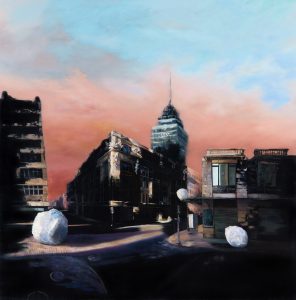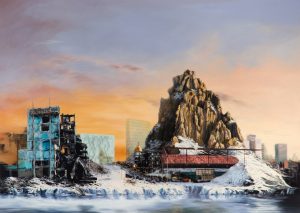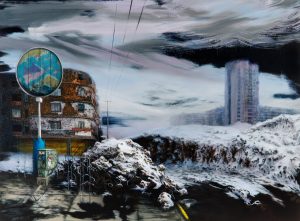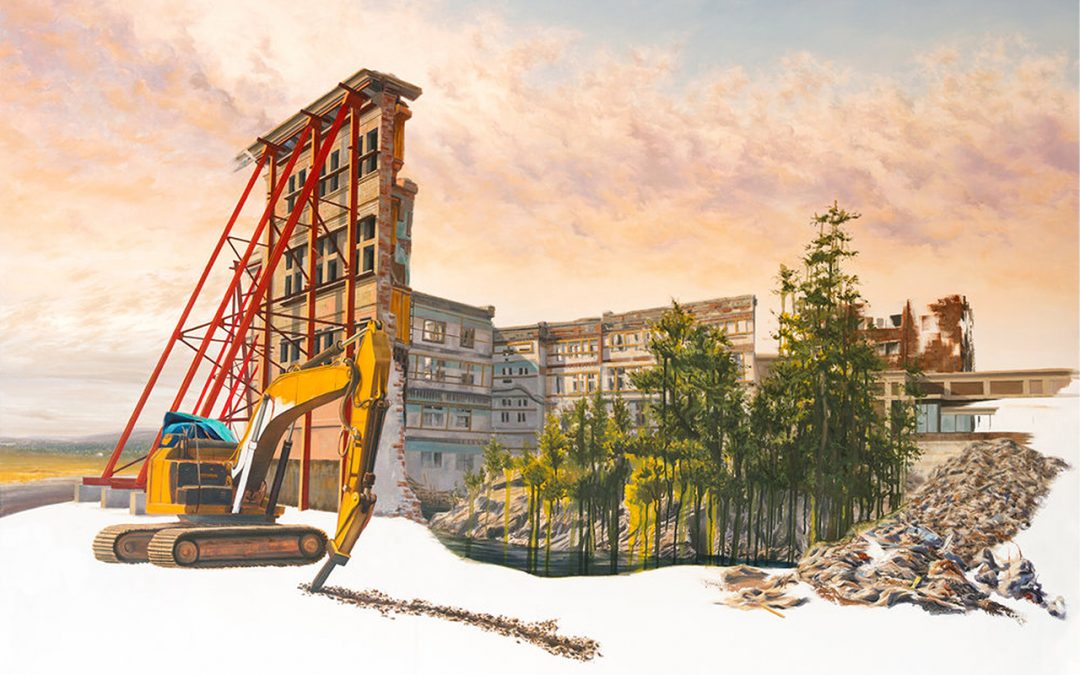Diego Narvaez is a 2019 Sooke Fine Arts Award of Excellence recipient and intentionally renown artist originally from Mexico City.
What do you hope people will do, see, feel, etc from viewing your work?
Art is a bridge between people, knowledge, emotions, pursuits for meaning. This requires time and nowadays we know that is a scarce resource. I hope that through my work people take the time to stand in front and ask themselves what do they feel what do they thinks by having this encounter with such a landscape.
I never look for specific messages to be handed to the viewer, I rather create open metaphors, set some questions about the ways we relate to our surroundings. I believe the understanding of our realities have much to do with the way we observe or the lack of it. Painting can be a radical medium in this sense because it asks us to stop and really question the way we see things.
Do you see artists as catalysts for change? If so, how?
 Yes, I think that can be one of the ways artists can work, but not all of them are interested in doing so. I believe art can be a trigger of thought, a seed with so much potential to question ourselves and expand the ways we understand our reality and the ways we live. Artists can question, propose, critique, challenge through their work and sometimes this happens without even trying to. Art is not here to convince anyone about anything but it can surely bring to mind questions on many subjects and from there the viewer can start a change.
Yes, I think that can be one of the ways artists can work, but not all of them are interested in doing so. I believe art can be a trigger of thought, a seed with so much potential to question ourselves and expand the ways we understand our reality and the ways we live. Artists can question, propose, critique, challenge through their work and sometimes this happens without even trying to. Art is not here to convince anyone about anything but it can surely bring to mind questions on many subjects and from there the viewer can start a change.
What are some of the biggest issues you think we are facing today? How can art and artists help with these issues?
We, as humans, are facing some of the most interesting challenges nowadays. Even if we don’t want to see them or think they are not important, there are some big changes happening right now and art is already working with these kind of issues, such as climate change, politics, social issues as housing, migration and boarders, food shortage, gender issues, corruption, etc.
I don’t believe in propaganda art or an art that tries to convince of a belief straight forward. For that means, there are better media like essays or articles, documentaries of many different subjects and kinds. I believe art can be much more subtle, not address only the rational part of the viewer, but it can send a more poetic and deep message that touches emotions and causes reactions in our body. There are many ways of connecting humans, and art is about expanding these channels and touch different layers of the human condition.
What would be your dream project/assignment?
 I am interested in creating art that gives way to question the ways in which we interact with our surroundings and understand our realities. What captivates me the most are the ever-changing landscapes; Polar landscapes fascinate me. My dream project would be to work in a interdisciplinary group of artists, scientists, creatives, designers, philosophers, etc. to create a body of work that can show the importance of the Poles and glaciers to the viewers in ways they can join and fell part of the project.
I am interested in creating art that gives way to question the ways in which we interact with our surroundings and understand our realities. What captivates me the most are the ever-changing landscapes; Polar landscapes fascinate me. My dream project would be to work in a interdisciplinary group of artists, scientists, creatives, designers, philosophers, etc. to create a body of work that can show the importance of the Poles and glaciers to the viewers in ways they can join and fell part of the project.
What is your process in creating a piece which incorporates social commentary? Do you first have a vision and apply the message, or have a message and create the vision?
That is like the question of the egg or the chicken. I believe vision and message or image and concept, in my case, are always feeding each other. It is a cycle that keeps on turning. Sometimes I read about the subjects that interest me and come with ideas for my art. Other times I just go and experience the places I want to work with and from there emerge some visions that I can then translate into paintings, drawings, writings… I feel it is all part of the same process and it is constantly changing. As I said before, I don’t like to send a fixed message but I am interested in asking the right questions through visual metaphors.
What inspired you to begin creating pieces incorporating our relationship to our surroundings/the natural world?
 It all started with an exercise when I was in art school. I was trying to learn about space and atmospheres, distances and light in the second year of school and I accidentally found images of icebergs that caught me instantaneously. Their mystery, the sublime of those gigantic masses of ice, the overwhelming tragedy yet enormous beauty of the breaking of ice. It was a deep connection that started through an aesthetic approach and later grew into a more complex relationship. I then realized that ever since I was a kid I had a sense of caring for nature and some ecological awareness. But this time it was like a call. This started in 2008 and now it has evolved to paint in frozen environments such as Iceland and Antarctica and afterwards to camping and painting in the ecosystems of the West Coast in North America.
It all started with an exercise when I was in art school. I was trying to learn about space and atmospheres, distances and light in the second year of school and I accidentally found images of icebergs that caught me instantaneously. Their mystery, the sublime of those gigantic masses of ice, the overwhelming tragedy yet enormous beauty of the breaking of ice. It was a deep connection that started through an aesthetic approach and later grew into a more complex relationship. I then realized that ever since I was a kid I had a sense of caring for nature and some ecological awareness. But this time it was like a call. This started in 2008 and now it has evolved to paint in frozen environments such as Iceland and Antarctica and afterwards to camping and painting in the ecosystems of the West Coast in North America.
What I want is to bring this closer to the viewer, as close as his/her daily life so that’s why I am interested in combining urban landscapes and natural elements and vice versa. I found that by doing this, new possibilities or ways of approaching landscape would emerge and my art gained more meanings than just a surreal place.
Artist Statement
I work from the experience of place in a specific time to paint natural and urban landscapes. From Antarctica to Mexico City, Iceland to the West Coast of North America, I am interested in experiencing places that are in continuous transformation. These places allow me to contrast, but also to interweave the everyday with the sublime. I believe this is a powerful tool to look again around us instead of taking for granted our surroundings. I paint this kind of landscapes to be able to construct and erase, detail or just insinuate what a place could be for any of us, like a memory, like the way our perception constructs what we call reality. In this sense, each of my paintings is not fully done, it needs the observer to happen; it exists only when seen. I believe painting can help us to see deeper and then question the way we perceive and therefore interact with our surroundings.
I am interested in going beyond mere representation, for this reason, I seek to paint and draw in the wilderness, as well as in the city, reflecting how we affect our reality when approaching the landscape and how the environment influences our perception.
I believe perception is the key to understanding the context and this understanding or the lack of it derives in the different ways in which we relate with our surroundings. I have learned that looking for the right questions is of much more value than constructing a fixed idea or answer. In this respect, I create paintings that work like open metaphors, rather than images with a unique meaning.
